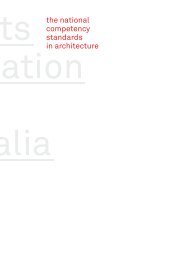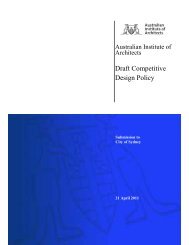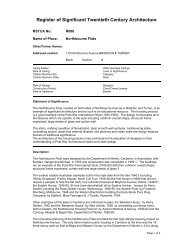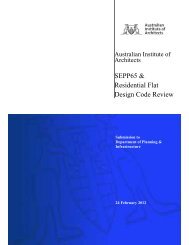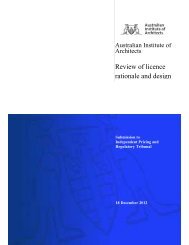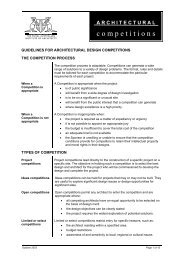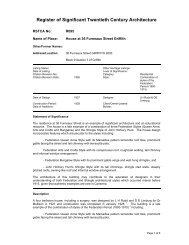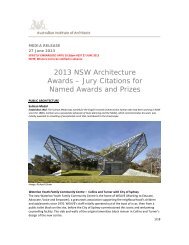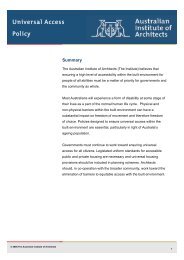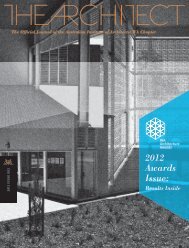January/February - Australian Institute of Architects
January/February - Australian Institute of Architects
January/February - Australian Institute of Architects
- No tags were found...
Create successful ePaper yourself
Turn your PDF publications into a flip-book with our unique Google optimized e-Paper software.
exhibitionbook reviewCurator’s note to the editorAfter ImagesOpening and auction: 28 October, 6–8pmExhibition: 28 October – 12 NovemberBoutwell Draper Gallery82–84 George Street, RedfernIn April 1966 the <strong>Australian</strong> Governmentopened a large trade display in a Tokyodepartment store. Among the toy koalas,sporting paraphernalia and industrialproducts were two Sydney Opera Housemodels, and it was in front <strong>of</strong> these thatthe <strong>of</strong>ficiating dignitaries chose to posefor the obligatory photo opportunities.Created to promote Australia’s nascentcultural aspirations internationally, themodels included a sectional model <strong>of</strong> JornUtzon’s last, unbuilt scheme for the MajorHall. Ironically, the rather different ConcertHall we have today drew inspiration for itsfolded plywood forms from a Kunio Maekawadesignedauditorium near Tokyo. Clearly,despite our best intentions, the culturalinterchange between Australia and Japanhas never amounted to anything approachinga two-way affair, and it is to Japan that many<strong>Australian</strong> architects and artists are indebtedfor the philosophical and aesthetic ideas thathave framed their careers.After Images, a recent exhibition andcatalogue, sought to capture and decodethe spirit <strong>of</strong> that inspiration. Created by RossAnderson, Tom Heneghan, and Keiko Hosoda,with the support <strong>of</strong> Paul Berkemeier, andrealised in collaboration with Aya Kaneko,Sean Bryen, and Kevin Liu, the project wasconceived as a fundraiser to assist Japan’srecovery from the devastating earthquakeand tsunami <strong>of</strong> March 2011.<strong>Architects</strong> were invited to contribute anartwork, no larger than A4, that had someconnection with Japan. Entries were to bedisplayed–Boutwell Draper Gallery generouslyprovided the space–and sold by silent auctionon opening night. Despite the arrival <strong>of</strong> onlyone contribution as the deadline for entriespassed, the organisers needn’t have worried.Deadline vagueness is a well-known affliction<strong>of</strong> creative types, and the project eventuallyattracted more than 60 fascinating entries.From Peter Armstrong’s atmospheric1971 watercolour landscape, to an entire 1989sketchbook by Neil Durbach, to John Wardle’sorigami-inspired wooden breakfast tray <strong>of</strong>2011, the works spanned a broad chronologicaland conceptual spectrum. Many were sketchesresponding directly to place: Luigi Rosselli’sode to the minimalistic mystery <strong>of</strong> the TeshimaArt Museum, Caroline Pidcock’s elegant linedrawing The Unlocked Bicycle in Tokyo (image 2),or Adam Russell’s clever Postcard to the Practice.Others used mixed media in a more abstractDear PeterJames MacCormick and his work was one <strong>of</strong>the real finds <strong>of</strong> this exhibition. I hadn’t heard<strong>of</strong> his <strong>Australian</strong> Pavilion at Osaka 1970, butTom Heneghan had, and wrote about it in hisexhibition catalogue essay. Heneghan got intouch with MacCormick (who must be in hiseighties now), and asked him if he had sketches<strong>of</strong> the building. He did, and sent us signedreproductions for the auction. He also wroteus an original text explaining the design ideas,which we have published in the catalogue [seean excerpt on the previous page]. The sketchesare wonderful, and a testament to a mode <strong>of</strong>careful architectural drawing that is generallylost to us in the digital age. The design isaudacious and visually compelling. If I wereto choose one image to print with this text,that would be it.Ross AndersonSenior Lecturer in Architecture: Design,History and Theory, University <strong>of</strong> Sydneyinterpretation <strong>of</strong> the brief: Brit Andresen’shaunting photomontages, Matt Chan’sMade in Japan collage and Damien Butler’smeticulously torn map <strong>of</strong> Japan. Residentin Tokyo during the March earthquakes,Tom Heneghan’s Ideas for a Folly was,surprisingly, one <strong>of</strong> the few entries topresent an architectural project. But it washis meditative catalogue essay that directlyexplored the enigma <strong>of</strong> Japan’s ineffablecontradictions, oppositions that wereexpressed visually in Richard Leplastrier’smasterful charcoal drawing Ma (image 4).Altogether, 89 ‘lots’ were auctioned,and a total <strong>of</strong> $15,000 raised on the night,which will be delivered through Emergency<strong>Architects</strong> Australia to an aid agency operatingon the ground in Japan. After Images did whata lot <strong>of</strong> exhibitions don’t do these days: it madeyou think and it made money!Anne WatsonDesign and architecture historian2. 3. 4.1.Artworks by architects auctioned on opening night <strong>of</strong> the exhibition. 1. James MacCormick’s <strong>Australian</strong> Pavilion at Osaka WorldExpo 1970. 2. Caroline Pidcock’s The Unlocked Bicycle in Tokyo. 3. Lee Stickells’ After Ozu. 4. Richard Leplastrier’s Ma.Design With LandscapeAuthor Bruce MackenziePublisher Bruce Mackenzie DesignRRP $95 plus postage. Order onlineat www.brucemackenzie.com.auBruce Mackenzie’s Design With Landscapeis a personal account <strong>of</strong> his long anddistinguished career in landscapearchitecture, which has spanned morethan a half a century. By anyone’s standardit represents an extraordinary body <strong>of</strong> work;but when one considers that Mackenzie (whoturns 80 this year), has written, designed andpublished the book himself, one cannot helpbut admire his unflagging energy, versatilityand careful attention to detail.Mackenzie’s early years were shaped bycity living and weekend explorations in thebush. His career as a landscape designer waslaunched in the early 1960s when he becameclosely associated with a number <strong>of</strong> ‘SydneySchool’ architects: Modernists who soughtto create buildings that responded to theparticular light, forms, textures and colours<strong>of</strong> the Sydney landscape.From 1969 to 1977 Mackenzie shared<strong>of</strong>fices at 7 Ridge Street, North Sydneywith Bruce Rickard, Harry Howard, IanMcKay, Harry Seidler, David Moore, GordonAndrews, Harry Williamson and otherleading designers <strong>of</strong> the day. It was a richand lively environment where designerssocialised and exchanged ideas daily.It was during these times that the‘Sydney Bush School’ <strong>of</strong> landscapearchitecture developed, with Mackenzieplaying a leading role. Howard and Rickardplayed supporting roles, underpinned byAllan Correy, then head <strong>of</strong> the LandscapeSection <strong>of</strong> the NSW Public Works Department.Mackenzie’s first major public park, Balmain’sPeacock Point (known today as IllouraReserve), was opened in 1970. It launcheda movement that established the pr<strong>of</strong>ession<strong>of</strong> landscape architecture in Sydney, and pavedthe way for ecological design in Australia.A strong statement <strong>of</strong> Mackenzie’sphilosophy and approach is his landscapeconservation, done for the GovernmentArchitect, surrounding the Kuring-gai Collegecampus (now UTS) constructed 1968–85 inLindfield on the North Shore. Here we see anearly Sydney brutalist building surroundedby near pristine indigenous landscape,preserved at the behest <strong>of</strong> Mackenzie.Design With Landscape opens with thechapter Spirit <strong>of</strong> the Land, which describesthe landscape qualities <strong>of</strong> Australia (ingeneral) and Sydney (in particular) thathave inspired Mackenzie’s design philosophythroughout his career. Several diagrammaticcross-sections through the Sydney basinillustrate in clear, simple terms the ecologicalfactors thatshape the Sydney landscape. Mackenzie thenexplores his most significant projects, startingwith the pioneering harbourside parks <strong>of</strong>Illoura Reserve, Clark Island (1972) andYurulbin Park (previously Long Nose Point),Birchgrove (1975), and ending with the highlysuccessful Sydney Olympic Park, HomebushBay (2000), which is today still a work inprogress. In between there are a wide variety<strong>of</strong> projects — great and small — including hisown private gardens and the lesser known,but highly ambitious Sir Joseph Banks Park,Botany Bay, a project close to Mackenzie’sheart. The final chapter is biographical andreflective.Mackenzie has always been an avidphotographer and Design With Landscape iscertainly a marvellous photographic record.But it is also much more. The juxtaposition<strong>of</strong> plans, sections, perspectives, diagrams,before and after photos and commentaryallow the reader to understand Mackenzie’sdesign process and philosophy at a muchdeeper level than is normally the case.This is an important book in two ways:as a record <strong>of</strong> Australia’s recent landscapearchitectural heritage; and as an exploration<strong>of</strong> the foundations <strong>of</strong> ecological landscapedesign in this country. The book will appealto practising architects, planners andlandscape architects, both in Australia andoverseas, who seek to integrate built formwith the local environment, and who wishto create landscapes that are both sustainableand biodiverse. It will be a valuable teachingaid for students who, until now, have nothad access to a comprehensive study <strong>of</strong>Mackenzie’s work. The book will also appealto those members <strong>of</strong> the general public whoare passionate about design and the builtenvironment.Many Sydneysiders, I am sure, will besurprised that many <strong>of</strong> the urban landscapesthey inhabit are completely man-made.Design With Landscape makes the invisiblework <strong>of</strong> landscape architects visible, andthat can only be good for the pr<strong>of</strong>ession.Barbara Buchanan16Architecture Bulletin <strong>January</strong> / <strong>February</strong> 2012Architecture Bulletin <strong>January</strong> / <strong>February</strong> 2012 17




